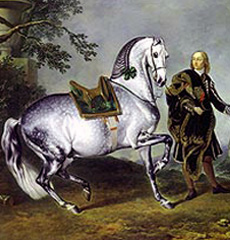

My horses are my friends, not my slaves. Reiner Klimke |
About Us |
| Our Location |
The Iberian horse has long been considered a treasure: for his skill in battle, for his beauty and swiftness, for his character and intelligence. A chance encounter with a young Andalusian colt several years ago convinced us that the Spanish horse was a breed to be examined more closely. Further contact led to our decision to breed these special horses; we have found them an absolute delight to be around and look forward to sharing this joy with you. The Aquila stud (pronounced ACK-will-ah) is located at the historic 'Bracken Brae' property in Victoria's western district, between Colac and Camperdown. The property was taken as a selection in 1865 by the Morrison family. The original property boasted a school, a general store (in which the hapless school teacher's miniscule lodgings were located), a cheese factory and a dance hall (strangely, referred to in the district as the Barn), where local dances were held up until the 1960s. The volcanic 'stoney-rises' (shallow gullies, low hillocks and escarpments, liberally scattered with blue stone rocks and native trees) which form part of the holding provided ample material for the construction of buildings and dry-stone walls.
Our Mares and Foals Many of the original features still exist; the general store building is unchanged, the original house still stands - albeit modified somewhat from the original blue-stone mid-Victorian 'box', and many of the dry-stone walls still fulfil their original purpose. The ruins of the old school building still remain on a now neighbouring property, and the remains of trenches, two 'forts' and a stone army kitchen - constructed by American soldiers based at the property during the second world war - are still in evidence.
The 'Cottage' (former General Store and lodging) Large paddocks of rich, flat pasture and sheltered, rocky bush land provide a congenial location for the keeping and raising of horses and cattle. |
|
Our Heilan' Coos (Scottish Highland Cattle) |
| Why 'Aquila'? |
Aquila is named after a constellation visible in the northern skies; not the best known constellation, perhaps, but a pretty one that features in the mythology of several cultures. The constellation was always known as Aquila - The Eagle - to the Romans (eventually becoming the 'official' name of the constellation, as recognised by the IAU), but was referred to as Aetos by the Greeks and Al'Okab by the Arabs. The earliest recorded reference to this constellation is believed to be from a Euphratean uranograpic stone from about 1200 BC. Greek and Roman mythology tells us that this Eagle was the loyal servant and companion of Zeus; the bird which carried Zeus' thunderbolts and administered punishment on Zeus' behalf to Prometheus for gifting the world with fire. Ganymede, "handsomest of mortals, whom the Gods caught up to pour out drink for Zeus and live amid immortals for his beauty's sake" (Homer, Iliad, Book XX) was found and taken up to Mount Olympus by sharp-eyed Aquila. Other Greek and Roman legends indicate that Aquila was one of the birds (along with Cygnus, the swan and Lyra, the Vulture) that were hunted by Hercules on his sixth labour. It is said that these birds were man-eaters, which haunted Lake Stymphalis in Arkadia. "Herakles when he came to Arkadia, was unable with bow Apollonius Rhodius, Argonautica 2.1052 For his services, Zeus immortalised Aquila, allowing him to fly eternally in the stars. Aquila lies on the celestial equator and is visible to the north in the evenings between July and November. During these months, it gradually proceeds from northeast to northwest in the night sky. It is also interesting that it was amongst the stars of the constellation Aquila, to the northwest of Altair (the constellation Aquila's brightest star), that Professor Edward Barnard discovered a comet (from its trail) on a photograph taken at the Lick Observatory on the 12th of October, 1892 - the first comet ever recorded on camera.
|


